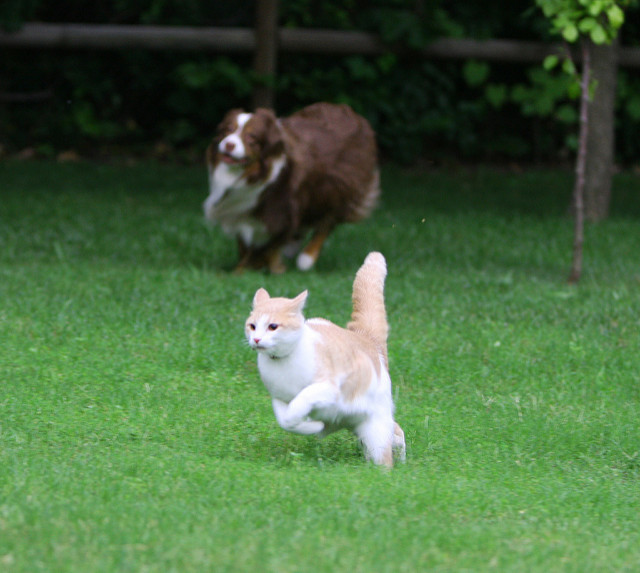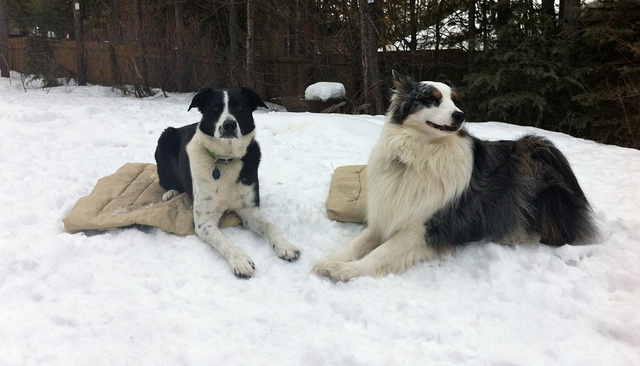Many dog owners struggle with dogs that chase anything that moves, particularly wildlife or outdoor cats in the neighborhood. It is possible to modify your dog’s behavior, but it takes a lot of time and patience. One article cannot possible cover all the methods and scenarios, but I can give some general tips on how to start teaching your dog to be calm around other animals. You will be most successful if you work with a professional positive reinforcement trainer near you.

Why Dogs Chase
First, let’s talk about why your dog chases. It’s simple: instinct. Your dog is a predator and all those cute furry and feathery creatures outside are prey. Regardless of whether your dog belongs to the hunting, herding or non-sporting group, all dogs have prey drive. Some have a little more than others. And some have way too much. These are often the dogs that are labeled “aggressive,” “reactive,” “impossible to train,” etc.
When a dog has too much drive and too little self-control, this is when training problems occur. The dog’s instincts and “drive” kick in and they physically can no longer listen to cues from an owner. Carolyn Wilki, a positive-reinforcement herding instructor in Pennsylvania explained to me that the “thinking” part of an over-aroused dog’s brain has shut down, and he is functioning fully on his instinctual brain. This is why your dog ignores you as he chases down that squirrel, not matter what you do or how much you scream.
Changing The Way Your Dog Reacts
It may sound impossible – you are talking about changing the way a dog’s brain works — and that’s why it takes so long. The reason Wilki was explaining this to me is because my herding dog, Merlin, has too much drive and almost no self-control. So I totally understand the place you are coming from – it’s frustrating, embarrassing, and even scary.
But I desperately want to herd and so does he. But he and I have very different ideas on what herding should look like. His brain says “chase those fluffy things wherever I please as fast as I can and bite them if possible,” while I want calm, controlled walking of stock toward me or toward a goal, such as a pen.
When I took him to see Wilki two years ago, we could not get within 40 yards of stock; he would be lunging and barking on lead if he could see them. (Note: he this did with pretty much anything that moved, not just stock). I am a dog trainer and I still was sure he would not be able to herd – it was impossible, I thought, to teach him to be calm.
For a year all we worked on was calming behaviors. Could he be calm around the livestock from 20 yards away? And gradually we got closer. And a little bit closer. One glorious day we walked calmly up to the fence. Even more importantly, we could turn away from the stock and walk away.

Now that Merlin is back in the herding ring, he still has moments where he “loses himself,” but we are almost to the point where we could try for our next pre-trial title. If I can get my crazy, over-the-top herding dog to be calm around stock, you can teach your dog, too–but it will take time and dedication!
A side note: he is also doing better with the kitties at the barn and does not try to chase airplanes or birds nearly as much as before!
How To Start
Since self-control, or the ability to keep themselves under threshold when a stimulus is presented, is the goal, you are going to start by teaching your dog to be calm. There are many, many methods to do this. Below are the ones I used with Merlin that I found useful.
Mat training – teaching your dog to settle calmly on a mat no matter what is going on around them can really help. The relaxation protocol is a good way to start. I also recommend Laura VanArendonk Baugh’s book Fired Up, Frantic, and Freaked Out.

Rewarding Calmness – Simply stated, you click (or use a marker word) and reward your dog whenever he offers a calm behavior, starting out in a semi-distracting environment. If he does anything else, you just ignore it. This reinforces the behavior you want, calmness.
Look At That/Auto Look – these are two “cues” that work together to help reactive dogs. You start at a distance from a stimuli that your dog can handle (i.e. not over threshold, trying to chase) and click/reward your dog for looking at the stimuli without reacting (no lunging, barking, etc.). When you reward, lure your dog’s head away with the treat towards you, then give him the treat. Eventually, it will turn into “Auto Look” – where your dog looks at the stimuli and then look back as you on his own for his reward.
Put it on cue – chances are, your driven dog loves a game of fetch or disc. But this game is encouraging (and reinforcing) your dog for chasing something. It’s okay to keep playing it, but put it on a cue. I use “go get it,” and for sheep he always gets a cue once I release him (a directional cue usually), so he knows he’s working and not just “chasing.”

A Few Other Resources
The above is just to get you started. Each individual dog is different and working with a trainer will avoid time-wasting mistakes and frustration at both ends of the leash. There are some great DVDS and books that can help you better understand your dog and how to train him. Here are some I recommend:
- Reliability for Reactive Dogs (DVD)
- Controlled Unleashed (book), also quite a few dog trainers offer a controlled unleashed class which can be very beneficial.
- Click To Calm (book)
- The Certification Council for Professional Dog Trainers – to find a positive reinforcement trainer near you.

